FIAT FREEMONT 2013 Owner handbook (in English)
Manufacturer: FIAT, Model Year: 2013, Model line: FREEMONT, Model: FIAT FREEMONT 2013Pages: 352, PDF Size: 5.22 MB
Page 211 of 352
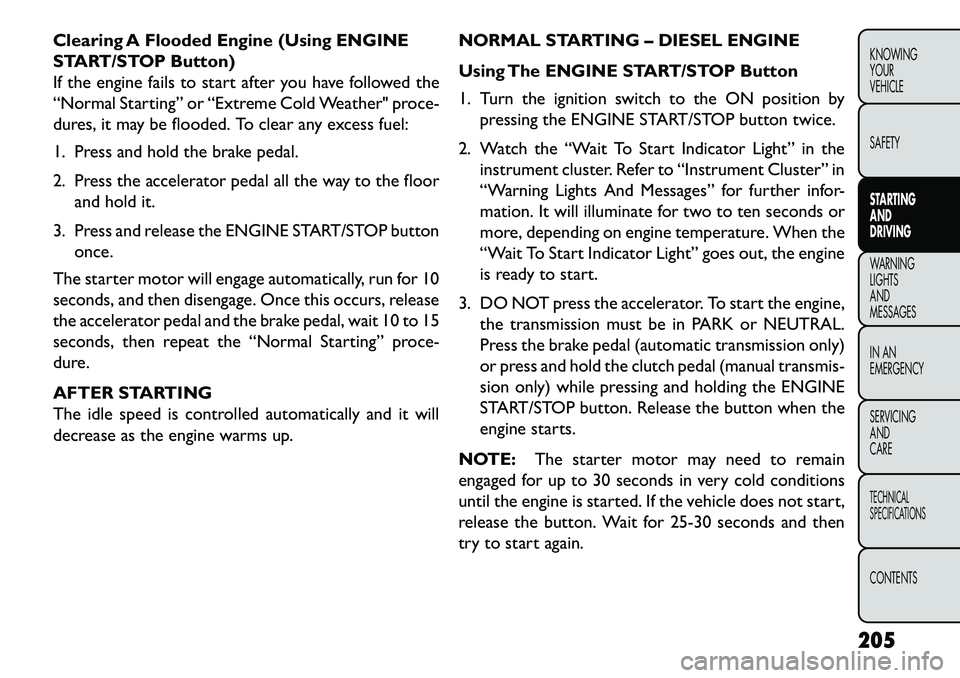
Clearing A Flooded Engine (Using ENGINE
START/STOP Button)
If the engine fails to start after you have followed the
“Normal Starting” or “Extreme Cold Weather" proce-
dures, it may be flooded. To clear any excess fuel:
1. Press and hold the brake pedal.
2. Press the accelerator pedal all the way to the floorand hold it.
3. Press and release the ENGINE START/STOP button once.
The starter motor will engage automatically, run for 10
seconds, and then disengage. Once this occurs, release
the accelerator pedal and the brake pedal, wait 10 to 15
seconds, then repeat the “Normal Starting” proce-
dure.
AFTER STARTING
The idle speed is controlled automatically and it will
decrease as the engine warms up. NORMAL STARTING – DIESEL ENGINE
Using The ENGINE START/STOP Button
1. Turn the ignition switch to the ON position by
pressing the ENGINE START/STOP button twice.
2. Watch the “Wait To Start Indicator Light” in the instrument cluster. Refer to “Instrument Cluster” in
“Warning Lights And Messages” for further infor-
mation. It will illuminate for two to ten seconds or
more, depending on engine temperature. When the
“Wait To Start Indicator Light” goes out, the engine
is ready to start.
3. DO NOT press the accelerator. To start the engine, the transmission must be in PARK or NEUTRAL.
Press the brake pedal (automatic transmission only)
or press and hold the clutch pedal (manual transmis-
sion only) while pressing and holding the ENGINE
START/STOP button. Release the button when the
engine starts.
NOTE: The starter motor may need to remain
engaged for up to 30 seconds in very cold conditions
until the engine is started. If the vehicle does not start,
release the button. Wait for 25-30 seconds and then
try to start again.
205
KNOWING
YOUR
VEHICLE
SAFETY
STARTING
AND
DRIVING
WARNING
LIGHTS
AND
MESSAGES
IN AN
EMERGENCY
SERVICING
AND
CARETECHNICAL
SPECIFICATIONSCONTENTS
Page 212 of 352
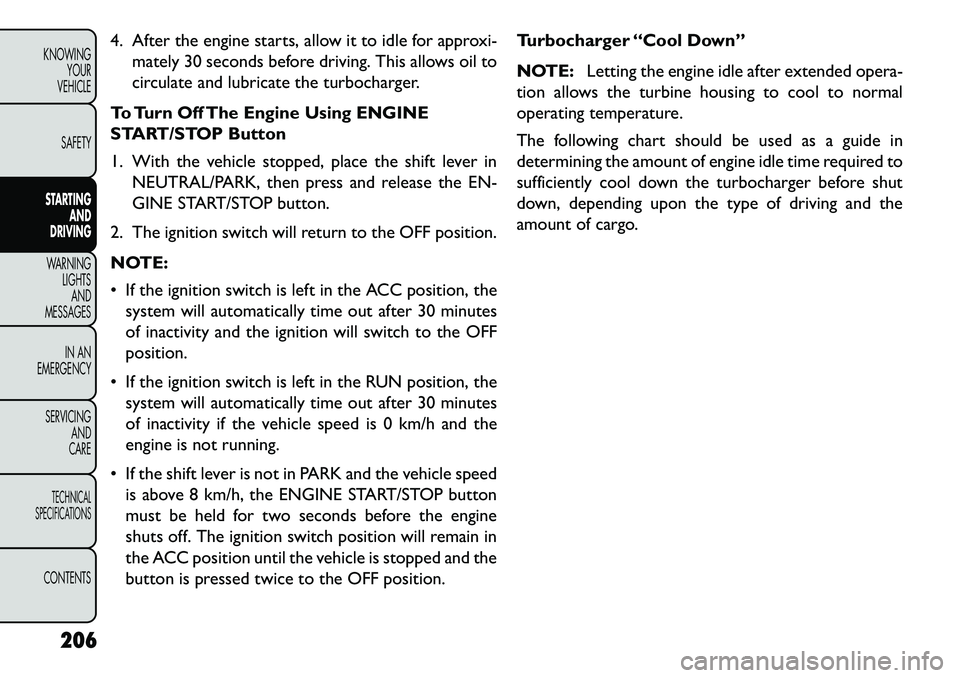
4. After the engine starts, allow it to idle for approxi-mately 30 seconds before driving. This allows oil to
circulate and lubricate the turbocharger.
To Turn Off The Engine Using ENGINE
START/STOP Button
1. With the vehicle stopped, place the shift lever in NEUTRAL/PARK, then press and release the EN-
GINE START/STOP button.
2. The ignition switch will return to the OFF position.
NOTE:
If the ignition switch is left in the ACC position, the system will automatically time out after 30 minutes
of inactivity and the ignition will switch to the OFF
position.
If the ignition switch is left in the RUN position, the system will automatically time out after 30 minutes
of inactivity if the vehicle speed is 0 km/h and the
engine is not running.
If the shift lever is not in PARK and the vehicle speed is above 8 km/h, the ENGINE START/STOP button
must be held for two seconds before the engine
shuts off. The ignition switch position will remain in
the ACC position until the vehicle is stopped and the
button is pressed twice to the OFF position. Turbocharger “Cool Down”
NOTE:
Letting the engine idle after extended opera-
tion allows the turbine housing to cool to normal
operating temperature.
The following chart should be used as a guide in
determining the amount of engine idle time required to
sufficiently cool down the turbocharger before shut
down, depending upon the type of driving and the
amount of cargo.
206
KNOWING YOUR
VEHICLE
SAFETY
STARTING AND
DRIVING
WARNING LIGHTSAND
MESSA
GES
IN AN
EMERGENCY
SERVICING AND
CARETECHNICAL
SPECIFICATIONSCONTENTS
Page 213 of 352
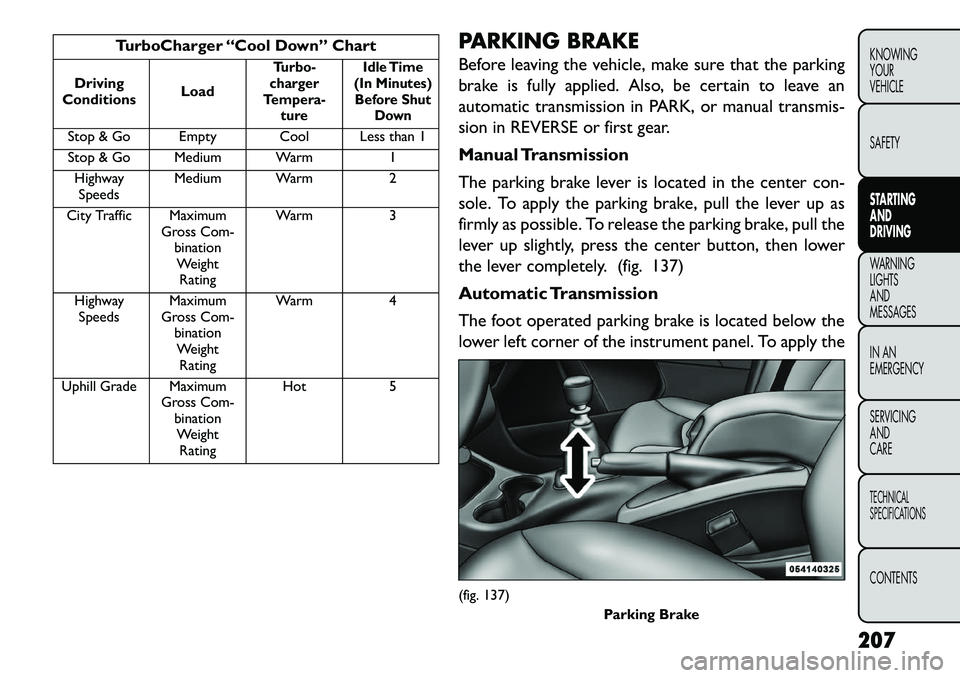
TurboCharger “Cool Down” Chart
Driving
Conditions Load
T
urbo-
charger
Tempera- ture Idle Time
(In Minutes) Before Shut Down
Stop & Go Empty Cool Less than 1
Stop & Go Medium Warm 1
Highway Speeds Medium Warm
2
City Traffic Maximum Gross Com-binationWeight Rating Warm
3
Highway Speeds Maximum
Gross Com- binationWeight Rating Warm
4
Uphill Grade Maximum Gross Com-binationWeight Rating Hot
5PARKING BRAKE
Before leaving the vehicle, make sure that the parking
brake is fully applied. Also, be certain to leave an
automatic transmission in PARK, or manual transmis-
sion in REVERSE or first gear.
Manual Transmission
The parking brake lever is located in the center con-
sole. To apply the parking brake, pull the lever up as
firmly as possible. To release the parking brake, pull the
lever up slightly, press the center button, then lower
the lever completely. (fig. 137)
Automatic Transmission
The foot operated parking brake is located below the
lower left corner of the instrument panel. To apply the
(fig. 137)
Parking Brake
207
KNOWING
YOUR
VEHICLE
SAFETY
STARTING
AND
DRIVING
WARNING
LIGHTS
AND
MESSA
GES
IN AN
EMERGENCY
SERVICING
AND
CARETECHNICAL
SPECIFICATIONSCONTENTS
Page 214 of 352
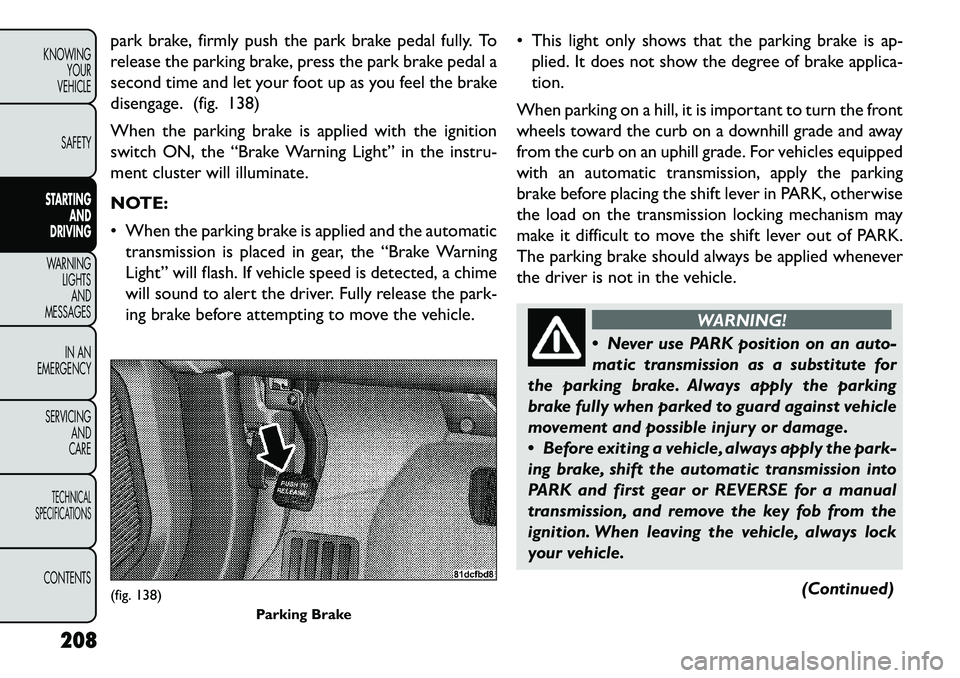
park brake, firmly push the park brake pedal fully. To
release the parking brake, press the park brake pedal a
second time and let your foot up as you feel the brake
disengage. (fig. 138)
When the parking brake is applied with the ignition
switch ON, the “Brake Warning Light” in the instru-
ment cluster will illuminate.
NOTE:
When the parking brake is applied and the automatictransmission is placed in gear, the “Brake Warning
Light” will flash. If vehicle speed is detected, a chime
will sound to alert the driver. Fully release the park-
ing brake before attempting to move the vehicle. This light only shows that the parking brake is ap-
plied. It does not show the degree of brake applica-
tion.
When parking on a hill, it is important to turn the front
wheels toward the curb on a downhill grade and away
from the curb on an uphill grade. For vehicles equipped
with an automatic transmission, apply the parking
brake before placing the shift lever in PARK, otherwise
the load on the transmission locking mechanism may
make it difficult to move the shift lever out of PARK.
The parking brake should always be applied whenever
the driver is not in the vehicle.
WARNING!
N
ever use PARK position on an auto-
matic transmission as a substitute for
the parking brake. Always apply the parking
brake fully when parked to guard against vehicle
movement and possible injury or damage.
Before exiting a vehicle, always apply the park-
ing brake, shift the automatic transmission into
PARK and first gear or REVERSE for a manual
transmission, and remove the key fob from the
ignition. When leaving the vehicle, always lock
your vehicle.
(Continued)
(fig. 138)Parking Brake
208
KNOWING YOUR
VEHICLE
SAFETY
STARTING AND
DRIVING
WARNING LIGHTSAND
MESSA
GES
IN AN
EMERGENCY
SERVICING AND
CARETECHNICAL
SPECIFICATIONSCONTENTS
Page 215 of 352
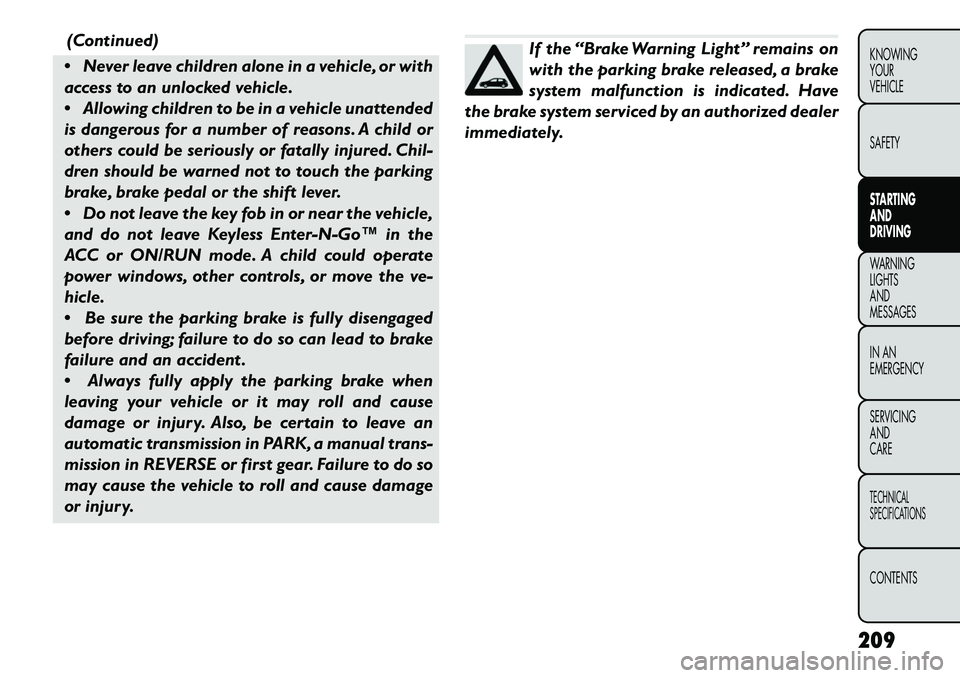
(Continued)
Never leave children alone in a vehicle, or with
access to an unlocked vehicle.
Allowing children to be in a vehicle unattended
is dangerous for a number of reasons. A child or
others could be seriously or fatally injured. Chil-
dren should be warned not to touch the parking
brake, brake pedal or the shift lever.
Do not leave the key fob in or near the vehicle,
and do not leave Keyless Enter-N-Go™ in the
ACC or ON/RUN mode. A child could operate
power windows, other controls, or move the ve-
hicle.
Be sure the parking brake is fully disengaged
before driving; failure to do so can lead to brake
failure and an accident .
Always fully apply the parking brake when
leaving your vehicle or it may roll and cause
damage or injury. Also, be certain to leave an
automatic transmission in PARK, a manual trans-
mission in REVERSE or first gear. Failure to do so
may cause the vehicle to roll and cause damage
or injury.
If the “Brake Warning Light” remains on
with the parking brake released, a brake
system malfunction is indicated. Have
the brake system serviced by an authorized dealer
immediately.
209
KNOWING
YOUR
VEHICLE
SAFETY
STARTING
AND
DRIVING
WARNING
LIGHTS
AND
MESSAGES
IN AN
EMERGENCY
SERVICING
AND
CARETECHNICAL
SPECIFICATIONSCONTENTS
Page 216 of 352
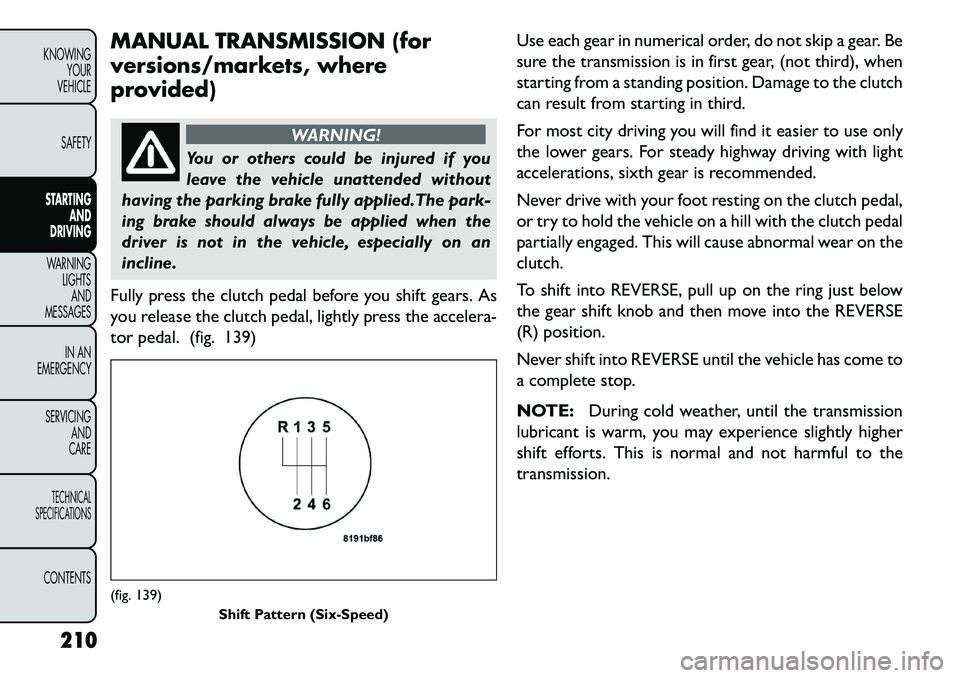
MANUAL TRANSMISSION (for
versions/markets, where
provided)
WARNING!
You or others could be injured if you
leav
e the vehicle unattended without
having the parking brake fully applied.The park-
ing brake should always be applied when the
driver is not in the vehicle, especially on an
incline.
Fully press the clutch pedal before you shift gears. As
you release the clutch pedal, lightly press the accelera-
tor pedal. (fig. 139) Use each gear in numerical order, do not skip a gear. Be
sure the transmission is in first gear, (not third), when
starting from a standing position. Damage to the clutch
can result from starting in third.
For most city driving you will find it easier to use only
the lower gears. For steady highway driving with light
accelerations, sixth gear is recommended.
Never drive with your foot resting on the clutch pedal,
or try to hold the vehicle on a hill with the clutch pedal
partially engaged. This will cause abnormal wear on the
clutch.
To shift into REVERSE, pull up on the ring just below
the gear shift knob and then move into the REVERSE
(R) position.
Never shift into REVERSE until the vehicle has come to
a complete stop.
NOTE:
During cold weather, until the transmission
lubricant is warm, you may experience slightly higher
shift efforts. This is normal and not harmful to the
transmission.
(fig. 139) Shift Pattern (Six-Speed)
210
KNOWING YOUR
VEHICLE
SAFETY
STARTING AND
DRIVING
WARNING LIGHTSAND
MESSA
GES
IN AN
EMERGENCY
SERVICING AND
CARETECHNICAL
SPECIFICATIONSCONTENTS
Page 217 of 352
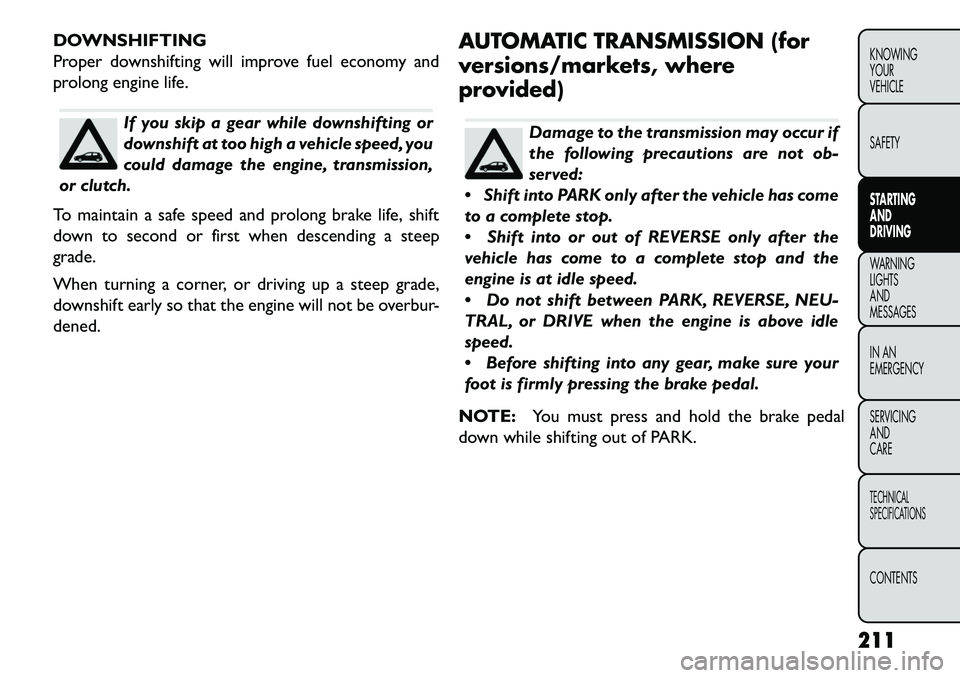
DOWNSHIFTING
Proper downshifting will improve fuel economy and
prolong engine life.
If you skip a gear while downshifting or
downshift at too high a vehicle speed, you
could damage the engine, transmission,
or clutch.
To maintain a safe speed and prolong brake life, shift
down to second or first when descending a steep
grade.
When turning a corner, or driving up a steep grade,
downshift early so that the engine will not be overbur-
dened. AUTOMATIC TRANSMISSION (for
versions/markets, where
provided)
Damage to the transmission may occur if
the following precautions are not ob-
served:
Shift into PARK only after the vehicle has come
to a complete stop.
Shift into or out of REVERSE only after the
vehicle has come to a complete stop and the
engine is at idle speed.
Do not shift between PARK, REVERSE, NEU-
TRAL, or DRIVE when the engine is above idle
speed.
Before shifting into any gear, make sure your
foot is firmly pressing the brake pedal.
NOTE: You must press and hold the brake pedal
down while shifting out of PARK.
211
KNOWING
YOUR
VEHICLE
SAFETY
STARTING
AND
DRIVING
WARNING
LIGHTS
AND
MESSAGES
IN AN
EMERGENCY
SERVICING
AND
CARETECHNICAL
SPECIFICATIONSCONTENTS
Page 218 of 352
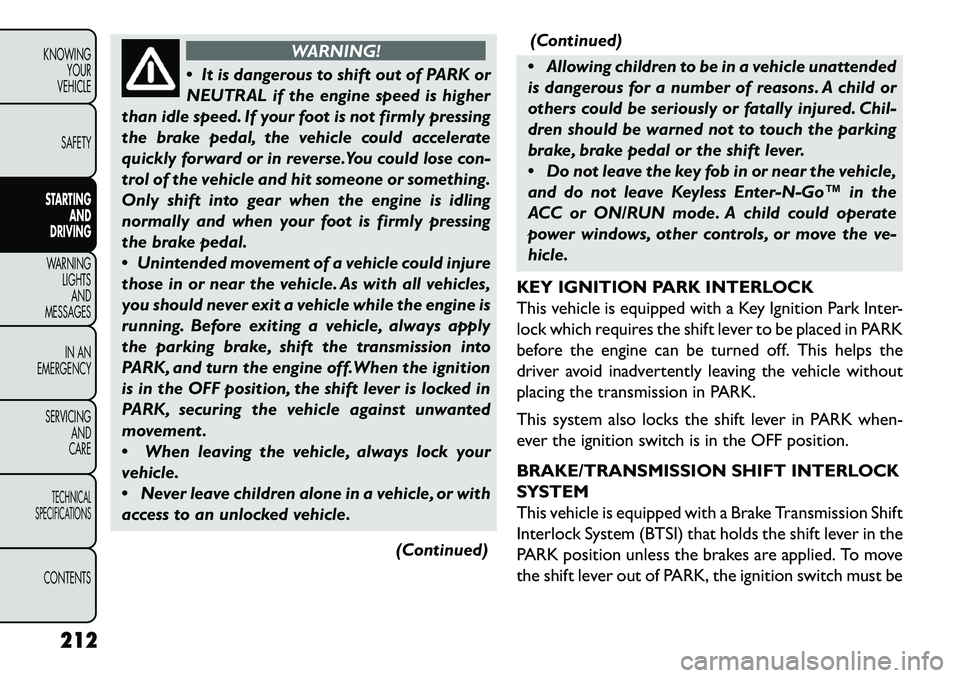
WARNING!
It
is dangerous to shift out of PARK or
NEUTRAL if the engine speed is higher
than idle speed. If your foot is not firmly pressing
the brake pedal, the vehicle could accelerate
quickly forward or in reverse.You could lose con-
trol of the vehicle and hit someone or something.
Only shift into gear when the engine is idling
normally and when your foot is firmly pressing
the brake pedal.
Unintended movement of a vehicle could injure
those in or near the vehicle. As with all vehicles,
you should never exit a vehicle while the engine is
running. Before exiting a vehicle, always apply
the parking brake, shift the transmission into
PARK, and turn the engine off.When the ignition
is in the OFF position, the shift lever is locked in
PARK, securing the vehicle against unwanted
movement .
When leaving the vehicle, always lock your
vehicle.
Never leave children alone in a vehicle, or with
access to an unlocked vehicle.
(Continued)(Continued)
Allowing children to be in a vehicle unattended
is dangerous for a number of reasons. A child or
others could be seriously or fatally injured. Chil-
dren should be warned not to touch the parking
brake, brake pedal or the shift lever.
Do not leave the key fob in or near the vehicle,
and do not leave Keyless Enter-N-Go™ in the
ACC or ON/RUN mode. A child could operate
power windows, other controls, or move the ve-
hicle.
KEY IGNITION PARK INTERLOCK
This vehicle is equipped with a Key Ignition Park Inter-
lock which requires the shift lever to be placed in PARK
before the engine can be turned off. This helps the
driver avoid inadvertently leaving the vehicle without
placing the transmission in PARK.
This system also locks the shift lever in PARK when-
ever the ignition switch is in the OFF position.
BRAKE/TRANSMISSION SHIFT INTERLOCK
SYSTEM
This vehicle is equipped with a Brake Transmission Shift
Interlock System (BTSI) that holds the shift lever in the
PARK position unless the brakes are applied. To move
the shift lever out of PARK, the ignition switch must be
212
KNOWING YOUR
VEHICLE
SAFETY
STARTING AND
DRIVING
WARNING LIGHTSAND
MESSA
GES
IN AN
EMERGENCY
SERVICING AND
CARETECHNICAL
SPECIFICATIONSCONTENTS
Page 219 of 352
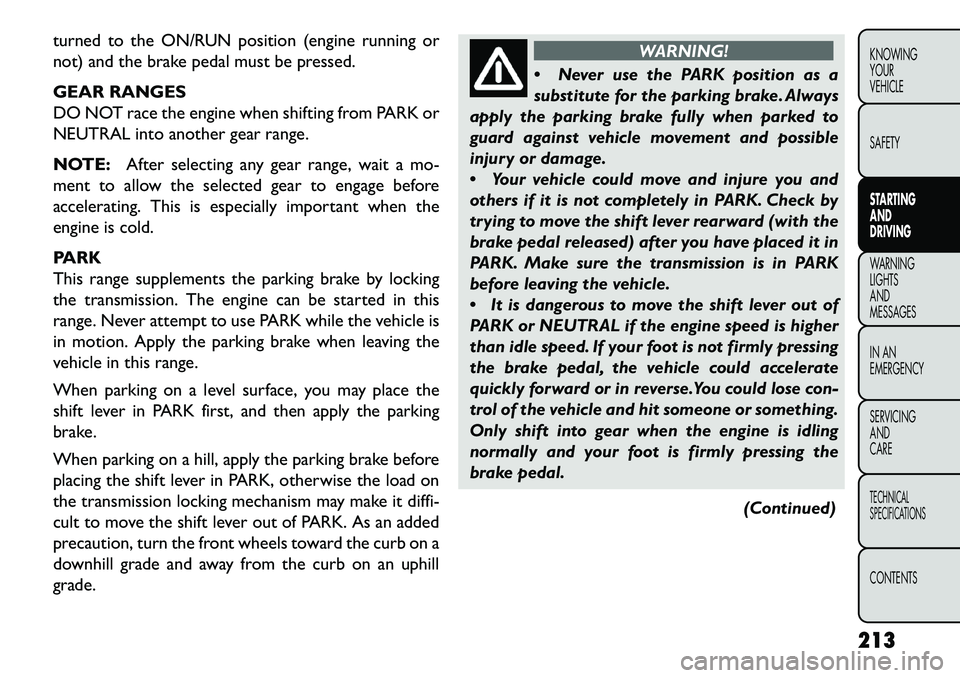
turned to the ON/RUN position (engine running or
not) and the brake pedal must be pressed.
GEAR RANGES
DO NOT race the engine when shifting from PARK or
NEUTRAL into another gear range.
NOTE:After selecting any gear range, wait a mo-
ment to allow the selected gear to engage before
accelerating. This is especially important when the
engine is cold.
PARK
This range supplements the parking brake by locking
the transmission. The engine can be started in this
range. Never attempt to use PARK while the vehicle is
in motion. Apply the parking brake when leaving the
vehicle in this range.
When parking on a level surface, you may place the
shift lever in PARK first, and then apply the parking
brake.
When parking on a hill, apply the parking brake before
placing the shift lever in PARK, otherwise the load on
the transmission locking mechanism may make it diffi-
cult to move the shift lever out of PARK. As an added
precaution, turn the front wheels toward the curb on a
downhill grade and away from the curb on an uphill
grade.
WARNING!
N
ever use the PARK position as a
substitute for the parking brake. Always
apply the parking brake fully when parked to
guard against vehicle movement and possible
injury or damage.
Your vehicle could move and injure you and
others if it is not completely in PARK. Check by
trying to move the shift lever rearward (with the
brake pedal released) after you have placed it in
PARK. Make sure the transmission is in PARK
before leaving the vehicle.
It is dangerous to move the shift lever out of
PARK or NEUTRAL if the engine speed is higher
than idle speed. If your foot is not firmly pressing
the brake pedal, the vehicle could accelerate
quickly forward or in reverse.You could lose con-
trol of the vehicle and hit someone or something.
Only shift into gear when the engine is idling
normally and your foot is firmly pressing the
brake pedal.
(Continued)
213
KNOWING
YOUR
VEHICLE
SAFETY
STARTING
AND
DRIVING
WARNING
LIGHTS
AND
MESSAGES
IN AN
EMERGENCY
SERVICING
AND
CARETECHNICAL
SPECIFICATIONSCONTENTS
Page 220 of 352
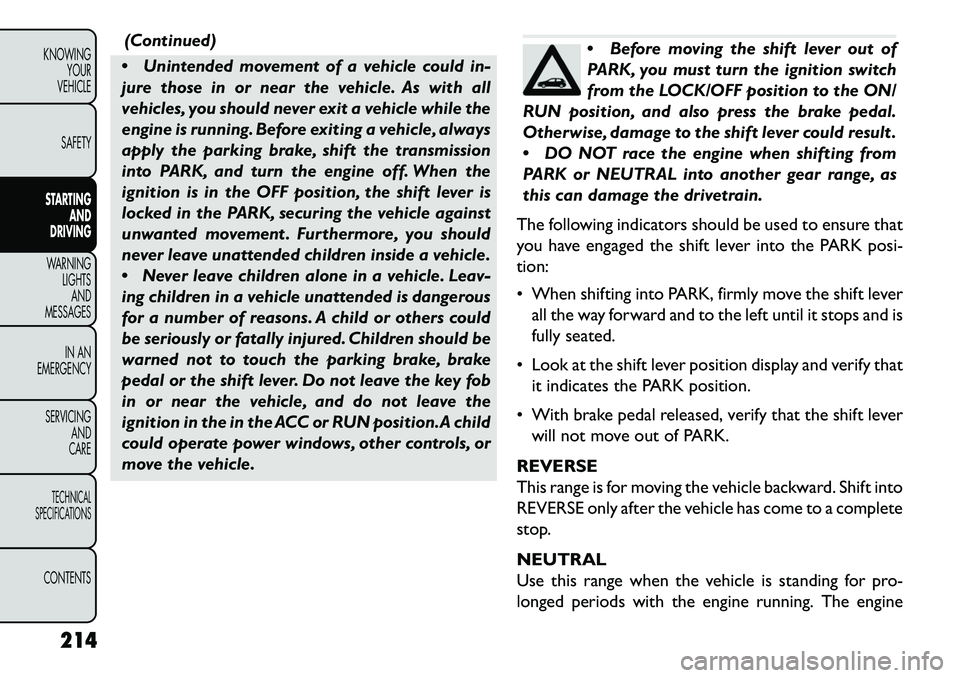
(Continued)
Unintended movement of a vehicle could in-
jure those in or near the vehicle. As with all
vehicles, you should never exit a vehicle while the
engine is running. Before exiting a vehicle, always
apply the parking brake, shift the transmission
into PARK, and turn the engine off. When the
ignition is in the OFF position, the shift lever is
locked in the PARK, securing the vehicle against
unwanted movement . Furthermore, you should
never leave unattended children inside a vehicle.
Never leave children alone in a vehicle. Leav-
ing children in a vehicle unattended is dangerous
for a number of reasons. A child or others could
be seriously or fatally injured. Children should be
warned not to touch the parking brake, brake
pedal or the shift lever. Do not leave the key fob
in or near the vehicle, and do not leave the
ignition in the in the ACC or RUN position.A child
could operate power windows, other controls, or
move the vehicle.
Before moving the shift lever out of
PARK, you must turn the ignition switch
from the LOCK/OFF position to the ON/
RUN position, and also press the brake pedal.
Otherwise, damage to the shift lever could result .
DO NOT race the engine when shifting from
PARK or NEUTRAL into another gear range, as
this can damage the drivetrain.
The following indicators should be used to ensure that
you have engaged the shift lever into the PARK posi-
tion:
When shifting into PARK, firmly move the shift lever all the way forward and to the left until it stops and is
fully seated.
Look at the shift lever position display and verify that it indicates the PARK position.
With brake pedal released, verify that the shift lever will not move out of PARK.
REVERSE
This range is for moving the vehicle backward. Shift into
REVERSE only after the vehicle has come to a complete
stop.
NEUTRAL
Use this range when the vehicle is standing for pro-
longed periods with the engine running. The engine
214
KNOWING YOUR
VEHICLE
SAFETY
STARTING AND
DRIVING
WARNING LIGHTSAND
MESSA
GES
IN AN
EMERGENCY
SERVICING AND
CARETECHNICAL
SPECIFICATIONSCONTENTS